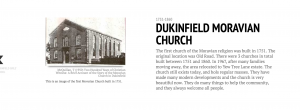Creating the timeline of the life of Samuel Tippett helped us understand the important aspects of his life and how the earlier part of his life impacted him later on. As Grafton mentioned, a timeline helps filter out facts and the important parts of history. And creating a timeline allowed us to see the most important parts of Tippett’s life, through a broader view. We were able to determine why he started becoming religious, what caused it. Although Tippett was not clear about the dates, we tried our best to estimate the dates.

The process of doing the Timeline.js project was fairly easy. Although it is not extremely detailed, it does have a lot of information on Tippett’s life. For example, it allows us to see quickly when he started following Jesus and when he went to Kingswood, when did he travel. We include a map in our timeline as it shows the important places Tippett travelled throughout his life.
Just as printing allowed timelines to grow in the 1800s, this website allowed us to use the technology we have today to develop it even further. We were able to add pictures, add events between and much more. Our timeline was more than a line, it allowed us to tell the story of Tippett in a different mode of presentation.
 Looking at a timeline, in complement to pure reading helps pick out the important dates, important years in history. There were details we wanted to include in the timeline but they were not important to Tippett’s story. There were some details that were not clear enough, so we could not include them. His father died when he was young but he does not say where or when. As Grafton said, the timeline let us pick precise facts and plot it in a line and observe how one influences the others. We can see Tippett’s early childhood, especially working at the coalpit has a huge impact in his future as he referred to it multiple times.
Looking at a timeline, in complement to pure reading helps pick out the important dates, important years in history. There were details we wanted to include in the timeline but they were not important to Tippett’s story. There were some details that were not clear enough, so we could not include them. His father died when he was young but he does not say where or when. As Grafton said, the timeline let us pick precise facts and plot it in a line and observe how one influences the others. We can see Tippett’s early childhood, especially working at the coalpit has a huge impact in his future as he referred to it multiple times.
Bhagawat Acharya is a Computer Science major at Bucknell University. He is interested in working at a cyber security firm after graduating from Bucknell University in 2020. Currently, he is a junior fellow for the Discovery Residential college.



